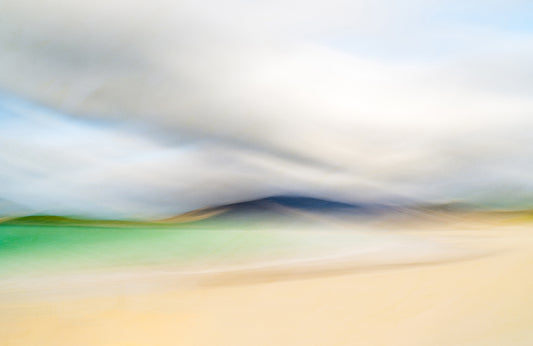My top tips for mastering ICM photography
sarah williamsonShare

In this blog post, i will briefly summarize the most frequently asked questions about this captivating style of contemporary photography, along with additional tips and advice based on my own experience.
What equipment do I need for ICM photography?
Camera - To capture ICM photographs, you will ideally need a camera with manual mode capability. I use Nikon Z6, which has a light body, great for the constant arm movements required with ICM. However, iPhones can also be used together with apps like Spectre, and Snapseed.
Lens - Although any lens could work, I recommend using either a 24-70mm or a 70-200mm lens, as they're best suited for landscape and seascape photography.
ND filters - It's also crucial to have a neutral density filter, particularly when shooting during challenging lighting conditions. For greater control, I prefer to use a 3 or 6-stop ND filter. I use the Lee Elements variable ND range and prefer a screw system rather than a holder, it’s just a personal choice.
Memory cards & batteries - Since you'll be capturing a lot of images, it's essential to have plenty of memory cards and batteries.

What are the best settings for ICM photography?
Exposure - For complete control over the exposure settings, you should set your camera to manual or shutter priority mode, depending on your comfort level.
Focus - Focus mode should be set to AF-C and focus area mode to single point AF.
Aperture - To reduce light sensitivity and allow longer exposures, adjust the aperture to ISO 100.
Shutter speed - The ideal shutter speed generally falls between 1.6 seconds - 2.5 seconds, but it depends on the movement you want to capture.
Additionally, it is recommended to turn off autofocus and anti-vibration settings as they will limit the ICM effect.

How do I achieve the intentional blur effect in my photos?
To achieve the intentional blur effect in your photos, you need to combine a slow shutter speed with movement.
However, keep in mind that the settings I suggest are only a guide and you will need to experiment with ICM photography to discover your style and the look you want to create.
A good rule of thumb to follow is that the slower the camera movement during exposure, the more recognisable the subject will be. Conversely, the faster the camera movement during exposure, the less detail will be visible in the subject.

Are there any particular techniques or movements I should practice for ICM?
When taking your first shot, use the initial frames to set up your composition, movement, exposure, aperture and shutter speed.
Have a vision of your composition before you start. Colour and contrast are key. Look for something to focus on - the line of a hill, a wave, the horizon etc and start moving the camera before pressing the shutter, this will help to define your image.
Handhold your camera and vary the speed of your movements, not using a tripod will help to create additional softness and depth.
It’s recommended to use the live view mode on your camera to see important information to be considered when capturing your image.
Pay particular attention to the histogram to ensure the correct exposure, under exposure can lead to noize, vignetting and loss of detail whilst over-exposure will also lead to loss of detail.
To create ICM, you can think of your camera as a paintbrush, it can help free up your movement. Using a wrist strap can also assist in this.
Here are some movements that you can consider when practising ICM. The faster you move during the exposure the less detail will be seen, and the slower the movement will deliver more detail and texture.
Panning with a horizontal or vertical movement.
Shaking or jiggling the camera.
Zoom burst by zooming in or out of your subject
Walking backwards and forwards
Swooshing with wave-like camera movements
Line flow by following the outline shape of the subject. This is the one I commonly use to define hills in my seascapes/landscapes.

How do I choose the right subjects for ICM?
To be honest, any subject can be incorporated into ICM. It all comes down to personal choice. However, some of the most commonly used subjects are:
Trees
Landscapes
Seascapes
Cityscapes
Flowers
People
Tips, thoughts & general advice
Finding your niche - The most common mistake to make with ICM is that it’s just about shaking the camera. Be prepared to fail at first. It takes a lot of time and patience to master the above techniques and achieve the results you want. Be your own worst critic, always believe you can improve and learn. Intentional camera movement (ICM) is a way to express your personality and enjoy creative freedom without the constraints of traditional techniques, a much-discussed topic in the photography World. There is no right or wrong when it comes to artistic direction. Do what you feel and embrace this still-emerging addictive form of abstract art.
Seeking inspiration - Get inspired and learn from others. There are many highly skilled and successful ICM/multi-exposure photographers you can follow on social media, and also so many up-and-coming ones. I also recommend looking at the art World, in particular Impressionist painters and contemporary artists. Here are some of them for your inspiration:
ICM Photographers - Shona Perkins, Andrew S Gray, Bill Ward, Charlotte Bellamy, Ron Ames, Erik Malm, Monique Hoogendijk, Rachel Talibart, Doug Chinnery, Annemarie Hoogwood, Sally Mason, Jocelyn Horsfall, Mark Cornick
Impressionist artists - Monet, Renoir, Pissarro, Manet, Degas.
Contemporary artists - Lesley Birch, Jess Gale, Emma Whitelock, Eva Ray, Colleen Conti, Bridget Greenwood, Anna Ertzbischoff, Neelam Padte, Ellis O Connor.
Communities, groups & courses
There are various ways to enhance your knowledge and inspire and motivate you about ICM. You can attend courses or join online groups where you can share images, thoughts and ideas. Below are some of the ones that I follow:
Facebook group - ICMphotomag - ICM photography magazine. They publish a quarterly magazine featuring inspiring photographers and run courses/workshops.
Facebook group - ICM Intentional camera movement photography
Facebook group - ICMphotography learning
Facebook group - Abstract landscape photography
You can also opt for location courses offered by some of the photographers listed above. This is a great way to learn the technique first hand from an expert.
Post-processing - Post-processing is a crucial step in developing images, and it deserves its own dedicated discussion. Here are a couple of quick tips to help you get the best possible results in the next stage:
Always shoot in raw format. Raw images are larger files, but they are best suited for getting the most out of your images.
Always clean your kit, dust spots are inevitable with ICM, albeit they can be removed in post-processing.
For my creative processing, I like to use a combination of Lightroom and Photoshop. I'll provide more details about my process in a future post.
Final word……Finally, it’s time to go out and have fun with your newly acquired ICM technique.
Be prepared to take lots of shots, some will be keepers others use them to learn from. I’m always amazed by what ICM can achieve; no two images are ever the same, and that is what I love - the freedom to create and enjoy observing what you see.
However, it is essential to be mindful of your safety and surroundings when practising ICM, especially if you’re shooting alone. Pre-check conditions, keep in mind the weather, sunrise, sunset, wind speeds, tide times and any challenging areas you may be walking through when out in the landscape.


